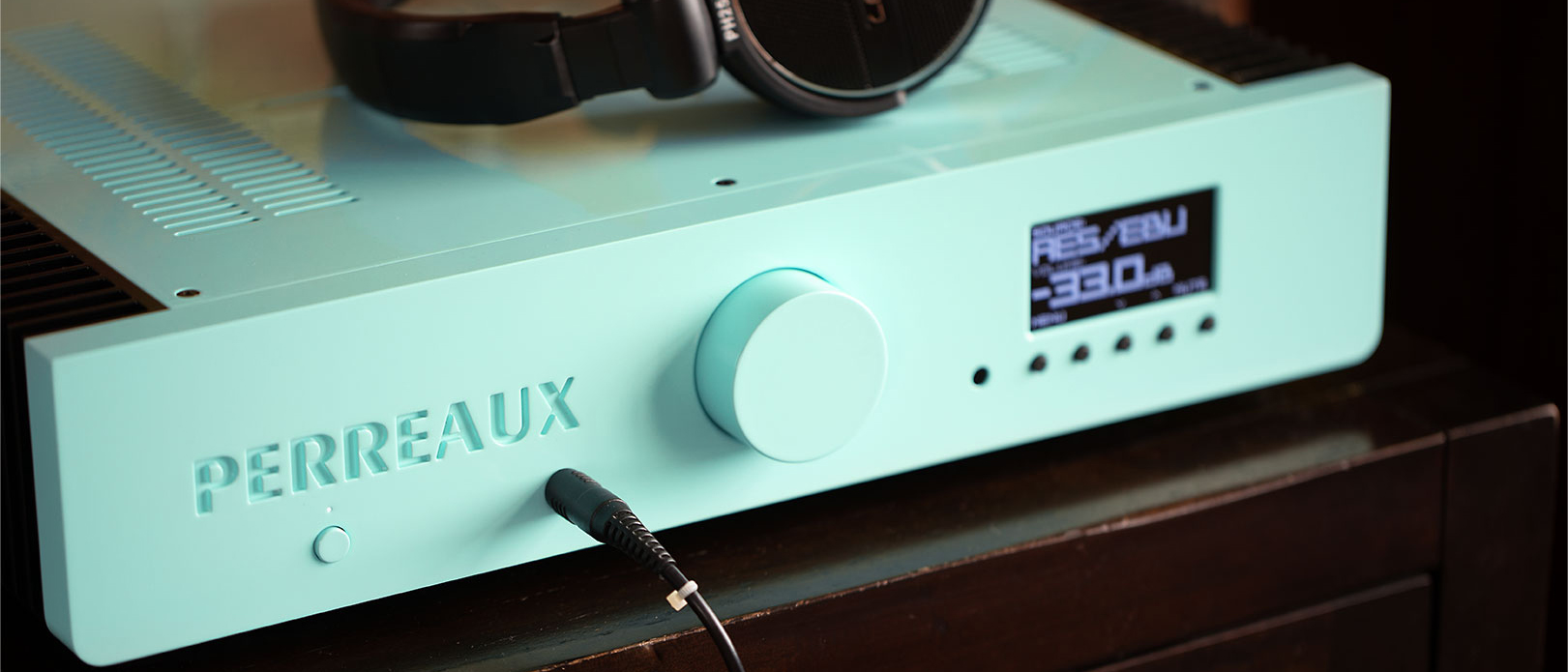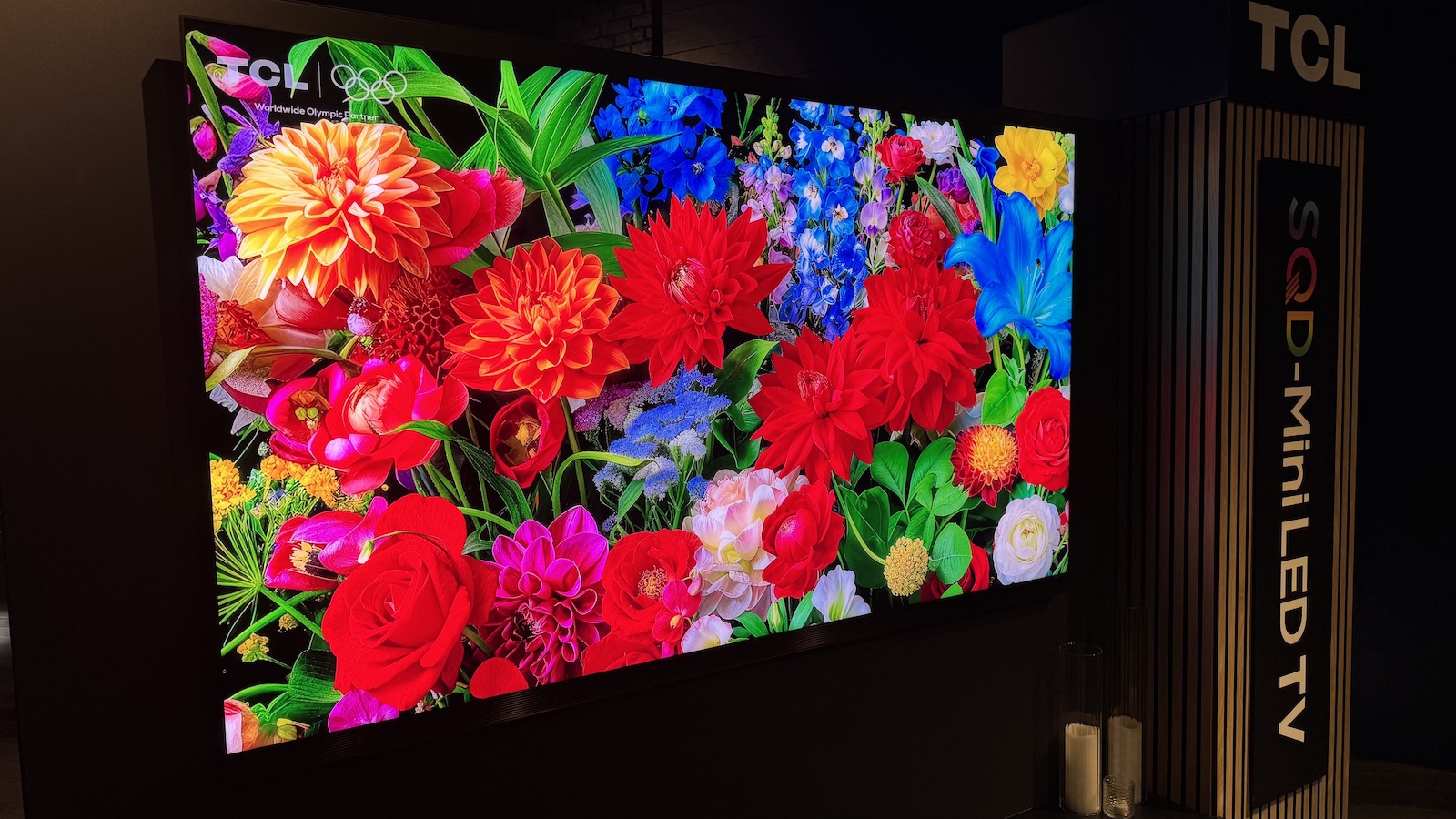What Hi-Fi? Verdict
A very high-performance amplifier that, thanks to myriad colour options, can be uniquely yours – there may be no other like it on the planet
Pros
- +
Power on tap to drive any loudspeakers
- +
Beautiful sound - clean, nuanced and distortion-less
- +
Any colour finish you like... or black
Cons
- -
Lightweight plasticky remote
Why you can trust What Hi-Fi?

This review and test originally appeared in Australian Hi-Fi magazine, one of What Hi-Fi?’s sister titles from Down Under. Click here for more information about Australian Hi-Fi, including links to buy individual digital editions and details on how best to subscribe.
Despite having one of the smallest populations in the world, New Zealand – or Aotearoa in its native Maori language – is renowned for punching well above its weight. So despite being the last country in the world to be inhabited by humans (c1320), it was the first country in the world to permit women to vote (1893).
New Zealand’s population is so small that it is outnumbered by its fleeced population, with almost nine times more sheep in the country than Kiwis. I mention this not only because it is a fact, but also because the video on Perreaux’s website that itemises the 200iX’s many features has the sound of sheep baa-ing in the background as a reminder.
And anyone wondering about exactly what a Kiwi might be, it’s a flightless bird that is the national symbol of New Zealand and is native to it, but the word is also used self-referentially by most people born in New Zealand, so they’ll say ‘I’m a Kiwi’ rather than ‘I’m a New Zealander’. This wasn’t always the case. Apparently, the descriptor only came into being after the First World War, during which Australian soldiers (called ‘Diggers’) started calling their New Zealand comrades ‘Kiwis’ and the name stuck.
New Zealand/Aotearoa (the literal meaning of the country’s Maori name is ‘land of the long white cloud’) also punches well above its weight in the field of audio, being home to two of the most famous audiophile amplifier manufacturers in the world, the names of which co-incidentally begin with the same letter of the alphabet – Plinius and Perreaux.
However, whereas Plinius was named to honour Pliny the Elder, a Roman author, naturalist, and natural philosopher, as well as naval and army commander of the early Roman Empire, and a personal friend of the emperor Vespasian, Perreaux was so-named because it was founded by Peter Perreaux.
Perreaux established his company in 1974 in Hawke’s Bay, Napier, on the east coast of New Zealand’s North Island, and he was one of the first amplifier manufacturers in the world to use the then-new Hitachi MOSFETs in his output stages. His MOSFET-based amplifiers were so successful that he rapidly expanded from being a one-man operation into a multi-million dollar business that in 1987 was exporting integrated and power amplifiers to 17 countries.
Perreaux sold his company to Martin Van Rooyen in 1995, who moved it down to Mosgiel on New Zealand’s South Island before retiring. The company is still in Mosgiel but is now owned by electronics engineer Edwin Nieman, the founder of the award-winning Dunedin-based electronics design company Kamahi Electronics where he heads a team of nearly two dozen electronics engineers.
The latest hi-fi, home cinema and tech news, reviews, buying advice and deals, direct to your inbox.
Nieman continues to champion the use of MOSFETs in Perreaux amplifiers, though he admits that they are costly devices that make life difficult for audio amplifier designers. “They are more difficult to drive than simple transistors,” he says, “so you need to master the art of controlling them. There’s also the problem that the good ones are expensive, which is why you rarely see MOSFETs in cheaper amplifiers.”
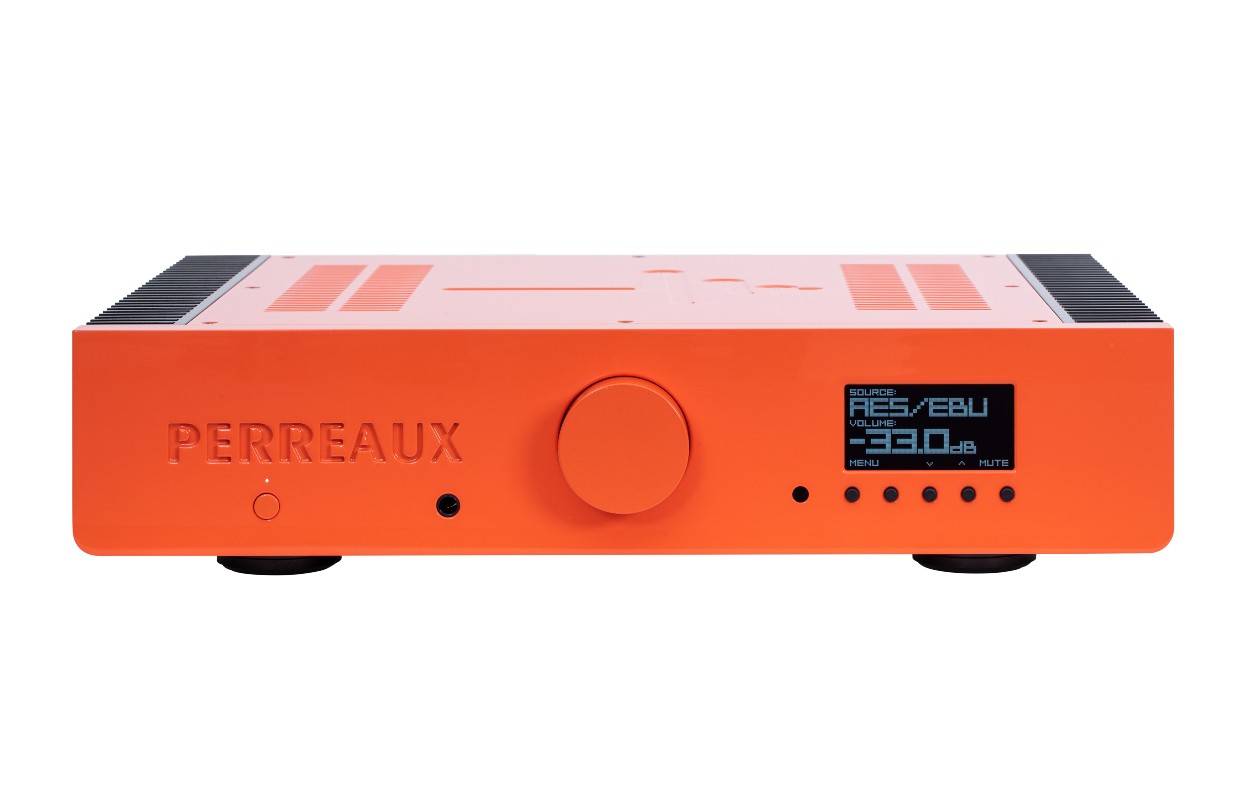
Equipment
You don’t need me to tell you what’s unique about Perreaux’s new 200iX. The lead photograph does that. There aren’t a great many gloss white amplifiers in the world. There are even fewer gloss pink ones. Or gloss orange, or gloss red, or gloss lime green ones... and these are only some of the standard colours in which you can buy a 200iX. And if none of these colours suit, you can order one “in any colour of your heart’s desire – or black,” says the company’s website.
However, whatever colour you decide on, you should note that the heat-sinking fins that run down the entire length of both sides of the amplifier will always be black, as will the rear panel. (And the underside, for that matter, though this is hardly relevant.) And do not be tempted to paint these yourself.
Black is the most effective colour for dissipating heat, and the two sets of heatsinks on the 200iX have to dissipate a lot of it, because the 200iX has a rated output of 230 watts per channel into 8Ω and 400 watts into 4Ω. Each heatsink is 300mm long, 85mm high and 40mm deep and has 29 ‘fins’.
You, like me, might be wondering why, since Perreaux’s model numbers usually reflect the amplifier’s power output (the 80i delivers 80 watts per channel, and the 100p delivers 100 watts per channel) the 200iX is not called the 230iX to reflect the power output assigned to it in its specifications sheet. I have no idea why not, so this is a question you should ask of Paul M. Sammes, Perreaux’s Global Sales & Marketing Manager.
It is, however, important to note that the Perreaux 200iX will deliver these high power levels into 8Ω and 4Ω loads only if the amplifier is in its default ‘High Impedance’ mode.
The 200iX is fitted with a user-selectable ‘Low Impedance’ mode which reduces the internal power supply rail voltage which in turn allows the amplifier to operate continuously into loudspeaker loads as low as 1Ω, though the reduced rail voltage means that the power output available when driving 2Ω will be reduced to around 100-watts per channel and to around 50-watts per channel when driving 4Ω loads.
Perreaux says that the 200iX will drive speaker impedances of 2Ω or less even if it’s in its default ‘High Impedance’ mode, but if operated at continuously high listening volumes into such loads, the amplifier will “generate excess heat and may enter protect mode.”
However, if you choose to use the ‘Low Impedance’ mode, the 200iX’s power output into higher speaker impedances will also be affected, effectively limited to less than 40 watts per channel for impedances of 8Ω and higher.
You might initially imagine that, after spotting the amplifier because of its unusual colouring, visitors to your home might have no difficulty identifying the manufacturer of your amplifier due to the fact that the Perreaux name is engraved on the front panel in lettering that’s 15mm high and 115mm long. There’s also a huge Perreaux ‘Impulse’ logo engraved on the top surface of the amplifier that is 150mm high and 162mm long.
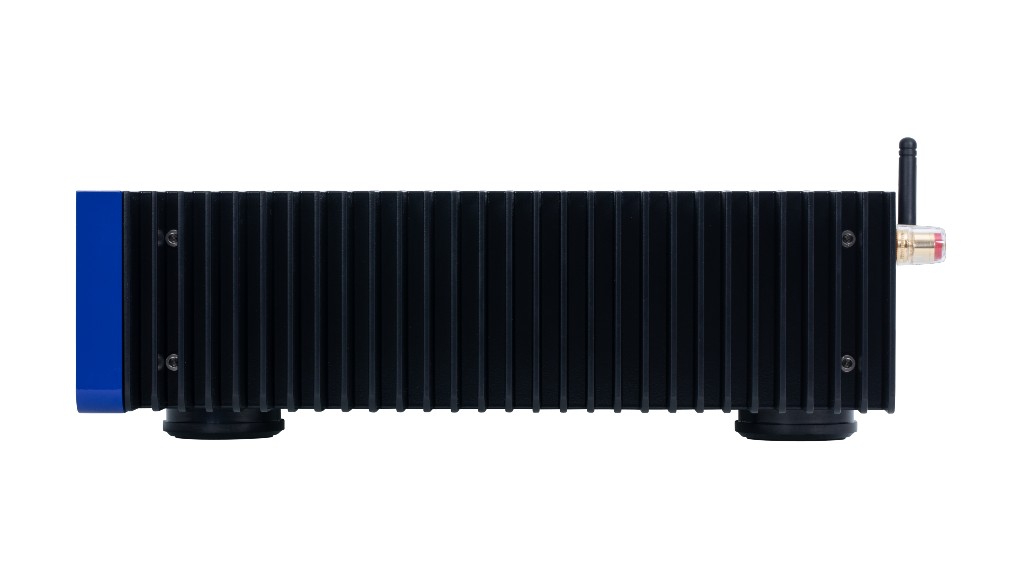
In fact, despite the size of the name and the logo, neither one of them is particularly obvious because there is no contrast between the engraved letters/logo and the background colour: At least there wasn’t with my review sample, which was finished in gloss white. It may be more obvious in one or more of the other optional colours.
When you are considering which colour you’d like your amplifier, you should take into account that the 6.35mm (¼ inch) headphone socket on the front panel will always be black (I would have thought using a gold-plated socket would have been a better choice).
This means that the headphone socket looks great on green and red models, would be invisible on black models, but is very obvious on white models (and likely on a few other colours as well). Also consider that the five small buttons underneath the front panel display will also be black, no matter what the colour of the amplifier.
Since I have mentioned the headphone socket, it’s probably a good time to also mention that whenever you plug a headphone jack into it, the amplifier will automatically mute the loudspeakers and whatever volume level you were listening at will be reset to –50dB (at least it will if you’re using the amplifier’s default volume settings).
If you then pull out the headphone jack, the speakers will unmute and start playing, but not at the level you were originally listening, but instead at whatever level you set the default volume ‘turn-on’ level to be.
All of which rather gives away the fact that the Perreaux 200iX not only allows you to set various different volume levels (Initial Volume, Maximum Volume, Mute Level and Bypass amongst them) but also allows you to specify whether you’d like the amplifier to ‘ramp’ the volume up (or down) to a particular level setting, or instead switch instantly from one level to another.
Regarding the Mute Level, you can set the degree of muting to be –10dB, –20dB, –30dB, –40dB or infinite, plus you can also set the mute ramping action to ‘Off’, ‘Fast’, ‘Medium’ or ‘Slow’.
You can also specify volume offsets that are dependent on which input you are using, to ensure speaker volume remains the same when switching from one input to another, even if the components connected to those inputs are delivering different voltages. Interestingly, ‘maximum’ volume is shown on the front panel display as +31.5dB (rather than 0dB, which I would have otherwise expected it to be), while the minimum is –96dB (whereas I would have expected –99.9dB).
As for the display (that shows volume level and other operational settings), it’s not particularly large, (64mm wide by 32mm high) and the type on it shows as light blue against black, which is very readable despite the fairly small type (about 2.5mm high). My only complaint is that instead of using upper and lower case lettering, almost everything is in capital letters that are so ‘blocky’ that the ‘A’s looked to me like ‘R’s. This means, for example, that I read ‘HEADPHONE’ as being ‘HERDPHONE’.
The menuing system used for the display is very logical and straightforward, which is good because there are dozens of user-selectable options that can be selected. Choose ‘Headphone’ for example, and you will be shown a submenu of (top to bottom) INITIAL (start-up volume), VOLUME TRIM (default +05.0dB), BALANCE, IMPEDANCE (8–250Ω or 250–500Ω) and CLASS-A (On Demand or Always On).
There’s also a ‘System Info’ screen that shows the Perreaux 200iX’s model number, serial number, build, firmware generation, and other relevant and not-so-relevant information. The DAC fitted is an ESS Sabre ES9038PRO that its maker claims is “the world’s highest performance 32-bit solution designed for audiophile and studio equipment applications such as SACD players, Blu-ray players, digital preamplifiers, A/V receivers, studio consoles and digital audio workstations.”
The display also shows which of the Perreaux 200iX’s ten inputs is selected. You can rename any or all of these inputs, and program a volume trim and a balance trim for it. Labels can be up to 11 letters (alphanumeric) plus there’s a selection of punctuation you can use, an apostrophe, three kinds of brackets, an oblique/forward-slash and a full stop. Everything is UPPERCASE though, so try not to use too many As!
You can also optionally set any of the 200iX’s inputs to bypass the internal volume control, and the amplifier’s ‘HT Loop’ input is set to do this by default. However, you can disable the bypass on the HT loop so that it becomes just a standard input (in which case it becomes ‘Input 4’), which essentially gives you an extra input if you’re not integrating the Perreaux into a multi-channel home theatre system.
Very unusually, you can set the digital ‘Coaxial 1’ input to bypass the volume control, which will enable you to use your DAC to control the volume level in the digital domain. It may be unusual, but it is a great idea and a very welcome option!
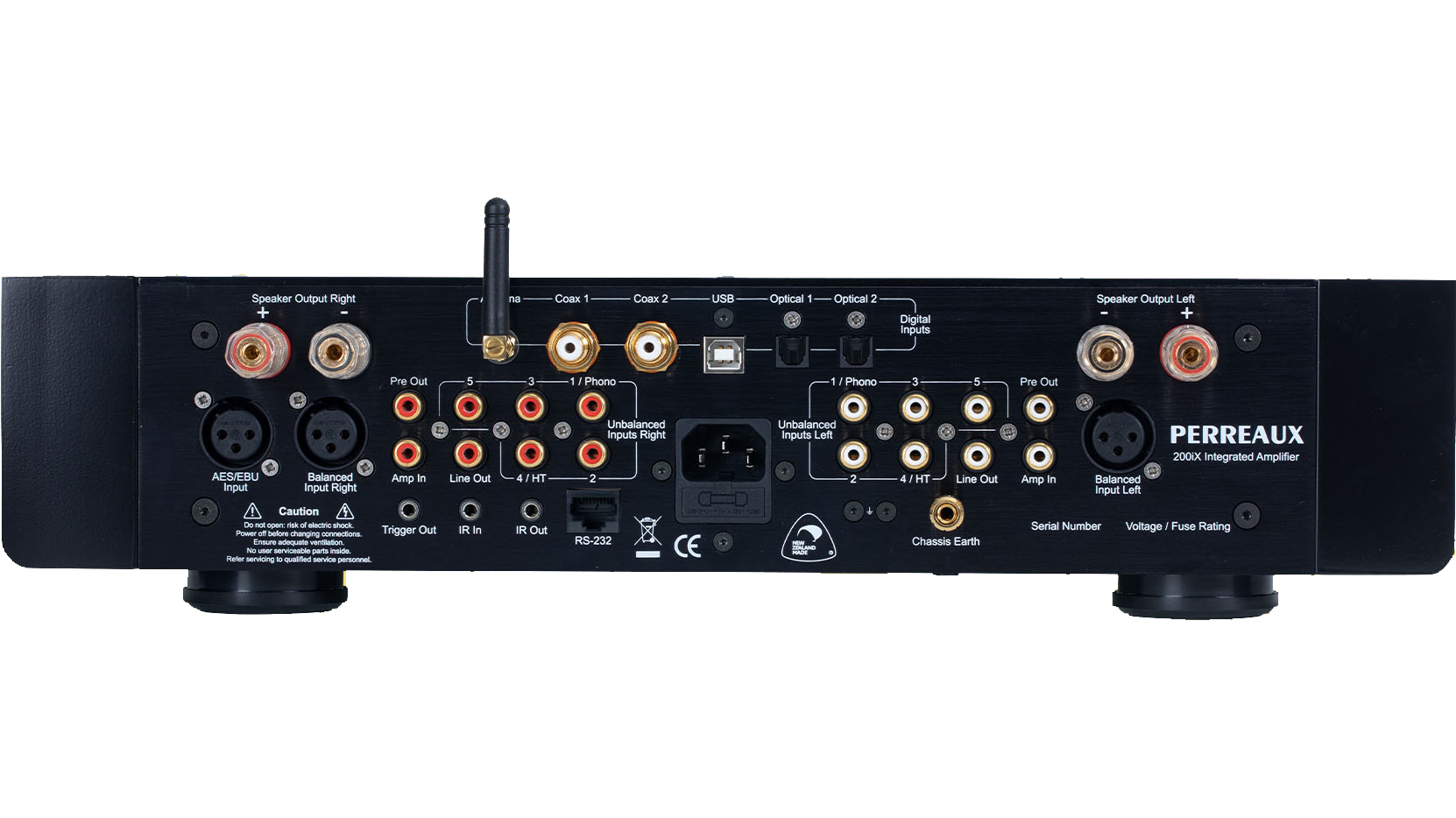
So far as inputs are concerned, you get four line-level inputs and one phono input. One of the line-level inputs is balanced, the other unbalanced. There are six digital inputs (two coaxial, one USB, one AES/EBU, and two optical). You can also input signals wirelessly via Bluetooth, for which a small stub antenna is fitted to the rear panel.
Menu selection on the front panel can be selected by using the push-buttons under the display or by rotating and pressing the volume control or you can mix both control options, which makes things faster because you can use both hands, like if you were fast-texting.
You can also use the remote control that comes standard with the Perreaux 200iX, rather than being an added-cost item. However, I think I would have happily paid extra for a remote if Perreaux would improve the quality of the one it does supply, which is a very light-weight plasticky affair that has sufficient buttons (42, shades of Douglas Adams!) to control not only the 200iX, but also other of Perreaux’s components.
However, saving money on the remote control was likely a good choice, since I expect many audiophiles will prefer to control this amplifier with their mobile phone or tablet, which they’ll be able to do thanks to Perreaux’s provision of apps for both iOS and Android.
The rear panel layout is initially confusing because of the way the analogue inputs are arranged. I would have put inputs 1, 2 and 3 on the top row, and inputs 4 and 5 on the bottom row, rather than staggered them up and down, the way Perreaux has done.
Perreaux has got the left/right stuff correct though, because the left channel is on the right-hand side of the rear panel (looking at it from the back) and vice versa, so your speaker cables will come out correctly and not ‘cross over’.
And once you get your head around where the inputs are located, you’ll find that all the terminals are gold-plated (including the chassis ground screw!) and of very high quality – most especially the gold-plated speaker terminals which have clear knobs, are colour coded, and are capable of accepting bare wire, as well as bananas and spade connectors.
MOSFETs vs. BJTs
I had to make that heading a bit technical because many people know that most amplifiers use ‘transistors’ in their output stages, so they usually ask the question: “Are MOFETs better than transistors” without realising that a MOSFET is a transistor.
The initials stand for Metal Oxide Semiconductor Field Effect Transistor. The question they should have asked is: “Is a Metal Oxide Semiconductor Field Effect Transistor better than a Bipolar Junction Transistor?”
Unsurprisingly, the answer will depend on who they ask. If they ask an audiophile, they’ll likely get told that MOSFETs are better than BJTs because MOSFETs “sound better because they have sonic qualities that are very similar to those of the very best valve amplifiers, with none of the drawbacks of valve amplifiers.”
If they ask an electronics engineer, they’ll likely get told that MOSFETs are better because they have a negative temperature coefficient, whereas BJTs have a positive temperature co-efficient, so MOSFETs are inherently stable. He (and it’s usually a ‘he’) will also tell them that “MOSFETs are very fast, with a much higher slew rate than BJTs.”
Said engineer might also mention that in the event of a transistor failure, BJTs tend to short-circuit, which connects the amplifier’s d.c. supply rail directly to the output which not only shorts out all the devices in parallel with the failed transistor but will also ‘fry’ the loudspeakers. MOSFETs, on the other hand, tend to fail ‘open-circuit’ so there are no downstream effects.

If the question is asked of an accountant, they’ll likely get told that BJTs are better because they’re not only much cheaper to buy than MOSFETs, but you generally need a much more complex (and thus much more expensive) power supply for a MOSFET amplifier than you do for an amp that uses BJTs.
If you asked me, I’d say that the circuit design and build quality of an amplifier is more important than the type of device that’s used in its output stage if we’re talking solely about sound quality. It is possible to build a superb-sounding amplifier no matter whether you use MOSFETs, BJTs… or even valves. Sure they will all sound ‘different’ but, if properly designed, they will all sound ‘good’.
Listening sessions
I have a little battery-powered oscillator that I often use to pre-condition amplifiers that I receive for review, so I used this to precondition the Perreaux 200iX, but after a few hours the amplifier went into a protection mode in which a warning on the front panel display appeared with the words ‘Protect! Please reset unit’ in a box superimposed over the main screen.
When I reset the unit all was well for a while until it happened again. After another reset, the amplifier never went into its protection mode again over the many (eight) months I was using it, so maybe it was just a bit trigger-happy at the outset due to being brand new.
There is certainly plenty of protection built-in, because the 200iX has microprocessor-controlled protection not only for the amplifier but also for your loudspeakers. This microprocessor circuitry includes protection against excessive current, over-temperature, d.c. offset and internal a.c. supply. There’s also conventional fuse protection. According to Perreaux, the protection circuitry is non-invasive and does not interfere with or degrade the audio signal path.
I discovered during the reset procedure that if you switch off the front panel’s power button, the 200iX will come back on switched to the same source you were using, but not at the volume level it was when it was switched off, but at the volume level you’ve pre-programmed for switch on.
I also discovered (but not in relation to this) that the balance control works in tiny 0.5dB increments all the way up to a monumental 40dB (either way) after which the display shows either LEFT or RIGHT to indicate that the other channel is effectively muted.
The amp can be handily operated in day-to-day use from the front panel, using the volume rotary, and the third and fourth of the pushbuttons in the row under the display to toggle through the inputs (the third for up and the fourth for down), while the furthest button to the right controls the Mute function.
The first button brings up the Menu while the second is only used to control options in the sub-menus, and is not used at all in the main menu. However, as I said earlier, I suspect most owners will use the Perreaux app to control the unit, even though it will likely be faster to use the front panel controls.
I rather liked that in addition to showing the volume as a digital display, volume level is also shown as a vertical bar that slides across the screen from MIN at screen left to MAX at screen right.
That said, I have to say that you’re not going to be seeing that vertical bar over towards the right-hand side of the screen very much, because the Perreaux 200iX is a veritable powerhouse that will easily be able to drive any loudspeakers you care to mention to volume levels far louder than your loudspeakers’ designer would want you to drive them to. It’s good, clean power too!
By way of example, I cranked up the volume of one of my favourite albums from last year, Turnstile’s ‘Glow On’. Right from the thrash start to Mystery (OK, pedants, it starts quietly, before the thrash kicks in) and the impact of the bass, guitars and drums is aurally startling. The speed of the 200iX is immediately apparent in the track that follows, Blackout.
Listen to the way that when the sound stops, it stops. No overhang at all. And when it starts, it comes out of nowhere. And I just loved the fact that even though I had the volume at stun, the cleaner and more ethereal sounds were delicately reproduced. On Don’t Play you can clearly hear that the drumming is syncopated, whereas lesser amps make it seem like a regular beat.
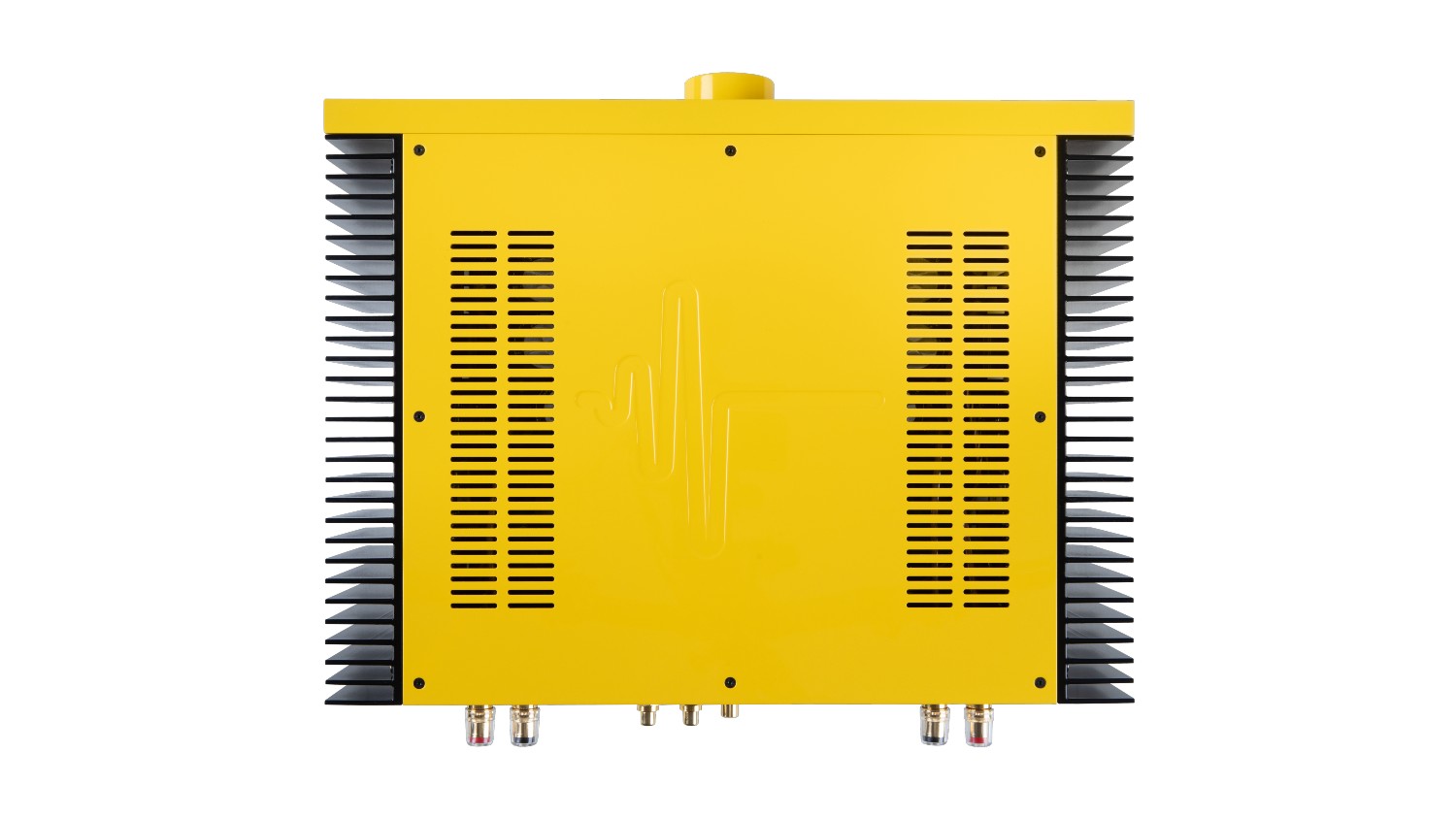
But if the Perreaux 200iX is packed with power, it can also do delicate as I proved by listening to another of my favourites from last year, which is Yasmin Williams’ delightful-sounding (and delightfully titled) album ‘Urban Driftwood’. Once you get used to the sound of the string scrapes that are caused by the unusual way she plays her guitar (like a keyboard), you’ll become totally captivated by the soundscapes she creates.
In opener Sunshowers she really does evoke an image of a sunny sky, with light rain pattering down through a rhythmic background. In I Wonder (Song for Michael) she separates out the melody from the accompaniment so you can hear the singing of her strings.
In Juvenescence the clarity of the harmonics is jaw-dropping. The delicacy and accuracy of the 200iX’s delivery mean not only that you’re essentially hearing a live performance, but also that there’s no aural effort required to listen, so you just find yourself sinking into the mood of the music so that you’ll be relaxed, smiling and ready for anything by the time the closer After The Storm comes around. Listening to this via the Perreaux 200iX I often found myself simply sitting in silent reverie after the album finished, lost in my own thoughts, rather than moving on to play another album so I could get on with this review.
I’d never sign off on an amplifier review without listening to piano, and although I won’t mention the many tried and true albums I auditioned using the Perreaux, one I would like to bring to your attention is 'Uneasy’, a new ‘free jazz’ album by the Vijay Iyer Trio, which is pianist/composer Vijay Iyer, Linda May Han Oh (bass) and Tyshawn Sorey (percussion/multi).
The 200iX delivered Iyer’s stabbing, stumbling, syncopated pianistic style with unerring accuracy and a gloriously real piano sound. The ECM recording is fabulous too, not only with the piano sound but also with the sound of Sorey’s percussion and the recording acoustic (listen to those echoes!).
You may have noticed that I have not so far mentioned whether I used the Perreaux 200iX’s ‘Low Impedance’ or ‘High Impedance’ mode for my listening sessions. Initially, I had intended to use both modes and report on the differences, but during my sessions, three of the speakers I used in conjunction with it had impedances that dipped down to 3.5Ω, 3.1Ω and 1.9Ω respectively.
Despite me pushing all three pairs of these speakers to very high volume levels for extended periods of time, the Perreaux drove them all brilliantly in its ordinary output mode, so I figured that if the 200iX could drive all these difficult loads in its ‘‘High Impedance’ mode, it could drive any speakers at all in this mode.
If I was impressed by the performance of the 200iX driving loudspeakers, I was absolutely blown away by its performance when it was driving headphones. So impressed was I that I hastened back to the company’s website to find out what Perreaux had done to make the phono sound so impressive.
What the clever Kiwi company has done is actually build its famous SXH2 Class-A headphone amplifier into the 200iX. And not just the output stage of that device... it also built in a completely separate power supply to drive it. It’s such a massive power supply that there is a circuit inside the 200iX that puts it into a ‘sleep’ mode if you have not plugged in your ‘phones.
What you’ll hear from whatever ‘phones you plug into the 200iX is tight, solid bass with not a hint of overhang, a midrange that’s so ultra-smooth and linear you could be plugging your ‘phones directly into the mixing desk and a deliciously sweet and refined treble. What you won’t hear when you’re listening is any background noise – no hiss, no hum, no noise at all, which means that combined with the power and drive of the circuit, you’re getting completely unfettered dynamics.
Final verdict
The Perreaux 200iX is such a desirable amplifier on so many levels. It has more than sufficient power on tap to drive any loudspeakers, with plenty to spare. It’s clean, distortionless sound too, with absolutely silent backgrounds. In short, it’s a beautiful-sounding amplifier. But it’s also an amplifier you can tailor to perfectly suit your requirements, by using the myriad control options built into it to allow you to perfectly match the 200iX to your various sources.
Then there are all the control options to consider – manual, custom remote, or from your phone or tablet. Plus, the multiple (myriad, even!) colour options mean that you can have all this high performance in an amplifier that will be uniquely yours – there may be no other like it on the planet. Yes please!
Australian Hi-Fi is one of What Hi-Fi?’s sister titles from Down Under and Australia’s longest-running and most successful hi-fi magazines, having been in continuous publication since 1969. Now edited by What Hi-Fi?'s Becky Roberts, every issue is packed with authoritative reviews of hi-fi equipment ranging from portables to state-of-the-art audiophile systems (and everything in between), information on new product launches, and ‘how-to’ articles to help you get the best quality sound for your home.
Click here for more information about Australian Hi-Fi, including links to buy individual digital editions and details on how best to subscribe.
